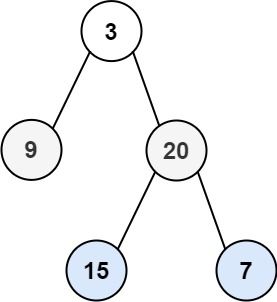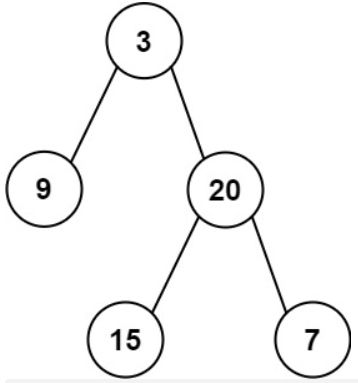C++——二叉树进阶oj题
目录
- 二叉树创建字符串
- 二叉树的分层遍历1
- 二叉树的分层遍历2
- 给定一个二叉树, 找到该树中两个指定节点的最近公共祖先
- 二叉树搜索树转换成排序双向链表。
- 根据一棵树的中序遍历与后序遍历构造二叉树
- 根据一棵树的前序遍历与中序遍历构造二叉树
二叉树创建字符串
题目链接
思路:
二叉树递归前序遍历的变形,对于一个根,根据题意有四种情况
1、左右孩子都存在:正常前序遍历递归
2、只有左孩子没有右孩子:需要遍历左孩子,让右孩子返回空字符串。
3、只有右孩子没有左孩子:在遍历右孩子之前要在前面加上(),为的是和上面只有左孩子没有右孩子的情况区分。
4、左右孩子都不存在:均返回空字符串。
实现代码:
class Solution {
public:
string tree2str(TreeNode* root) {
if(root==nullptr)
{
return string();
}
string ret;
ret+=to_string(root->val);
if(root->left)
{
ret+="(";
ret+=tree2str(root->left);
ret+=")";
}
if(root->left==nullptr&&root->right!=nullptr)
ret+="()";
if(root->right)
{
ret+="(";
ret+=tree2str(root->right);
ret+=")";
}
return ret;
}
};
二叉树的分层遍历1
输入:root = [3,9,20,null,null,15,7]
输出:[[3],[9,20],[15,7]]
题目链接
思路:
利用一个队列控制层序遍历的结点,因为题中要求返回vector,所以层序遍历的同时要记录当前走到第几层了,第一层和第二层的元素不能放在同一个vector中。
定义一个queue,先从根节点开始,将地址push到q中,设置一个T_level变量来标识层数,一开始设置为1,表示在二叉树的第一层,然后在q中每pop一个结点就让T_level-1,pop的同时如果左右孩子都不为空,那么把它的左右孩子也push,当T_level==0的时候,此时队列里就剩下下一层的元素了,把queue的size赋值给T_level,然后将刚才的vector尾插到vector中,再开始下一层的遍历。
实现代码:
class Solution {
public:
vector<vector<int>> levelOrder(TreeNode* root) {
vector<vector<int>> vv;
if(root==nullptr)
{
return vv;
}
queue<TreeNode*> q;
int T_level=1;
q.push(root);
while(!q.empty())
{
vector<int> tmp;
while(T_level--)
{
tmp.push_back(q.front()->val);
if(q.front()->left)
{
q.push(q.front()->left);
}
if(q.front()->right)
{
q.push(q.front()->right);
}
q.pop();
}
T_level=q.size();
vv.push_back(tmp);
}
return vv;
}
};
二叉树的分层遍历2
题目链接
思路:
将上一题的vector逆置一下即可。
实现代码:
class Solution {
public:
vector<vector<int>> levelOrderBottom(TreeNode* root) {
vector<vector<int>> vv;
if(root==nullptr)
{
return vv;
}
queue<TreeNode*> q;
int T_level=1;
q.push(root);
while(!q.empty())
{
vector<int> tmp;
while(T_level--)
{
tmp.push_back(q.front()->val);
if(q.front()->left)
{
q.push(q.front()->left);
}
if(q.front()->right)
{
q.push(q.front()->right);
}
q.pop();
}
T_level=q.size();
vv.push_back(tmp);
}
reverse(vv.begin(),vv.end());
return vv;
}
};
给定一个二叉树, 找到该树中两个指定节点的最近公共祖先
题目链接
思路:
写一个Get_Path函数把到两个结点的路径用两个stack记录下来,然后让路径长的出栈,直到两个结点的路径长度相同,此时从两个栈的栈顶开始比对看是否有相同的结点,一旦发现相同的结点,这个结点就是要找的最近公共祖先。
实现代码:
class Solution {
public:
bool Get_Path(TreeNode* &root, TreeNode* & FindNode,stack<TreeNode*>& path)//
{
if(root==nullptr)
{
return false;
}
path.push(root);
if(root==FindNode)
return true;
if(Get_Path(root->left,FindNode,path))
{
return true;
}
if(Get_Path(root->right,FindNode,path))
{
return true;
}
//以root的左右孩子为起点没有找到FindNode
path.pop();
return false;
}
TreeNode* lowestCommonAncestor(TreeNode* root, TreeNode* p, TreeNode* q) {
stack<TreeNode*> pPath;
stack<TreeNode*> qPath;
Get_Path(root,p,pPath);
Get_Path(root,q,qPath);
//两个栈倒着找
while(pPath.size()!=qPath.size())
{
if(pPath.size()>qPath.size())
{
pPath.pop();
}
else
{
qPath.pop();
}
}
while(pPath.top()!=qPath.top())
{
pPath.pop();
qPath.pop();
}
return pPath.top();
}
};
二叉树搜索树转换成排序双向链表。
题目链接
思路:
最简单的一种思路:用vector把二叉搜索树遍历的序列存起来,然后遍历vector,按双向链表的方式把它们链接起来即可。
递归的思路:另外写一个InorderConvert函数,中序遍历递归构建双向链表,这里设计函数的时候prev变量要加引用,cur表示当前结点。
实现代码:
class Solution {
public:
void InorderConvert(TreeNode*cur,TreeNode*&prev)
{
if(cur==nullptr)
{
return;
}
InorderConvert(cur->left, prev);
//画图才能较好的理解
cur->left=prev;
if(prev)
prev->right=cur;
prev=cur;
InorderConvert(cur->right,prev);
}
TreeNode* Convert(TreeNode* pRootOfTree) {
TreeNode*prev=nullptr;
InorderConvert(pRootOfTree,prev);
//前面已经链接好了,后面找双向链表的头,然后返回即可
TreeNode* head = pRootOfTree;
while(head&&head->left)
{
head = head->left;
}
return head;
}
};
根据一棵树的中序遍历与后序遍历构造二叉树
题目链接
输入:inorder = [9,3,15,20,7], postorder = [9,15,7,20,3]
输出:[3,9,20,null,null,15,7]
思路:
模拟建树的过程:
在后序遍历postorder中从后往前,可以依次确定一棵树的根在哪,确定根之后,
在中序遍历inorder中找到在后序遍历postorder中确定的根的下标N,
在中序遍历序列里再划分左右子树区间:[0,N-1]N[N+1,inorder.size()-1]
上面的例子中很显然第一次N==1
[0,0]是左子树区间,[2,4]是右子树区间
但是观察发现postorder的“根”从后往前,都是先右后左的,那么在确定根之后首先应该建立右子树,然后建立左子树。如果不这样的话,先建立左子树的话,结合上一步确定的左子树区间[0,0]以及postorder中下一次建树的根20,[0,0]中根本就找不到创建左子树的根20,那么就出错了。
然后根据在左右区间找到的根然后再建树,再递归。
实现代码:
//代码说起来容易写起来难!
class Solution {
public:
TreeNode*_buildTree(vector<int>& inorder, vector<int>& postorder,
int &posti,int inbegin,int inend)
//posti是标记当前的走到postorder的什么位置了,
//一定要加引用,因为左子树/右子树每创建一个结点
//都必须消耗postorder的一个节点。
//inbegin和inend分别是左右区间
{
if(inbegin>inend)
{
return nullptr;
}
TreeNode*root=new TreeNode(postorder[posti]);//先建树
//在inorder中根据postorder找根所在的位置,
//根据这个根的位置才能划分左右区间
int root_in_inorder=inbegin;
while(inorder[root_in_inorder]!=postorder[posti])
//当有一个结点的时候,提前posti--会导致越界
{
root_in_inorder++;
}
//上面工作都做好了,posti--
posti--;
root->right=_buildTree(inorder,postorder,posti,root_in_inorder+1,inend);
root->left=_buildTree(inorder,postorder,posti,inbegin,root_in_inorder-1);
return root;
}
TreeNode* buildTree(vector<int>& inorder, vector<int>& postorder) {
int postend=postorder.size()-1;//后序遍历的最后一个元素的下标
return _buildTree(inorder,postorder,postend,0,inorder.size()-1);
}
};
根据一棵树的前序遍历与中序遍历构造二叉树
题目链接
思路:
与前一题类似但也有不同之处。
根据前序遍历从前往后确定根,然后根据中序遍历确定左右区间,前序的话那就应该先建右子树,在建左子树,然后注意prei也就是记录前序遍历的坐标,一定要加引用,因为左子树/右子树每创建一个结点,都必须消耗postorder的一个节点。
实现代码:
class Solution {
public:
TreeNode* _buildTree(vector<int> & preorder,vector<int> &inorder,
int & prei,int inbegin,int inend)
{
if(inbegin>inend)
{
return nullptr;
}
//在inorder中根据preorder找根所在的位置,
//根据这个根的位置才能划分左右区间
int rooti=inbegin;
while(rooti<=inend)
{
if(inorder[rooti]==preorder[prei])
break;
++rooti;
}
TreeNode *root=new TreeNode(preorder[prei]);
prei++;
root->left=_buildTree(preorder,inorder,prei,inbegin,rooti-1);
root->right=_buildTree(preorder,inorder,prei,rooti+1,inend);
return root;
}
TreeNode* buildTree(vector<int>& preorder, vector<int>& inorder) {
int pi=0;//从前序遍历的第一个元素开始确定根的位置
return _buildTree(preorder,inorder,pi,0,inorder.size()-1);
}
};

